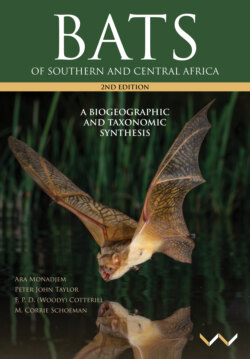Читать книгу Bats of Southern and Central Africa - Ara Monadjem - Страница 45
На сайте Литреса книга снята с продажи.
TYPES OF BAT ECHOLOCATION PULSES
ОглавлениеBroadband, low duty-cycle, frequency-modulated (LD-FM) echolocation pulses typically sweep downward through as much as an octave for a short duration of time (Fenton 1990, Schnitzler and Kalko 2001) (Figure 36). At the same time, the bat senses with increasing precision the range and position of the object in space – its localisation (Simmons and Stein 1980). This is because LD-FM signals sweep rapidly through the corresponding neural filters, and are therefore reliable time markers to determine the range of the target from the foraging bat (Moss and Schnitzler 1995). In addition, the neuronal filters are activated across a broad frequency range, which increases the reliability of the monaural and binaural cues the bat uses to localise the target in space (Schnitzler and Kalko 2001). Nevertheless, LD-FM signals are less suited for the detection of distant and/or weak echoes, because the neuronal filters are activated for only a short time (Schnitzler and Kalko 2001).
Figure 36. Diagram showing sonograms of southern African bats that use high duty-cycle and low duty-cycle echolocation calls.
Narrowband, low duty-cycle pulses composed of constant frequency (LD-CF) or shallow frequency-modulated (LD-QCF) components (Figure 36) are not suitable for localisation of a hunted target, but are well suited to detection, because they activate the neuronal filters of the corresponding narrow frequency band during the entire echo (Schnitzler and Kalko 2001). In addition, acoustic ‘glints’ (short prominent amplitude peaks in the echo that are created when a fluttering insect’s wing is perpendicular to the incoming sound wave) can be 20–30 decibel (dB) stronger than the echo from the body of the insect; it is these glints off the flying insect’s wings that further increase the likelihood of its detection by the bat (Kober and Schnitzler 1980, Moss and Zagaeski 1994).
In contrast to low duty-cycle bats, Doppler-shift compensation combined with a specialised auditory system enables constant frequency high duty-cycle (HD-CF) echolocating bats to localise and classify fluttering insects in dense (clutter) habitats (Schnitzler and Kalko 2001). HD-CF bats can classify insects by listening to the unique acoustic glints imprinted by the fluttering wings of different insects onto the echoes of their CF calls (Schnitzler 1987, von der Emde and Menne 1989, von der Emde and Schnitzler 1990) (Figure 36).
